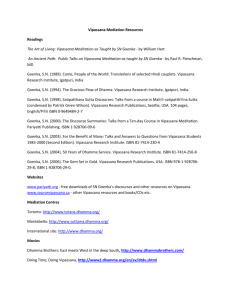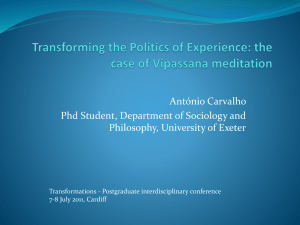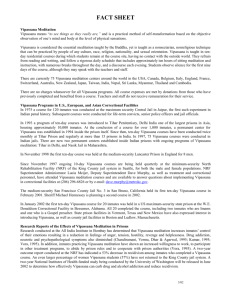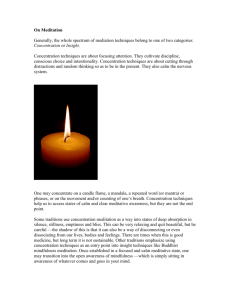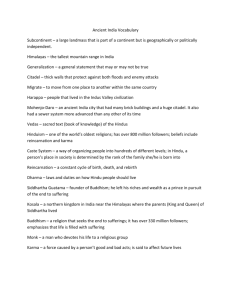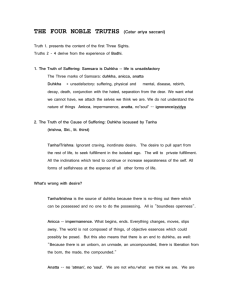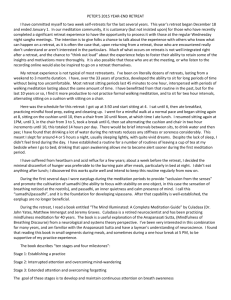1 VIPASSANA MEDITATION: A TOOL FOR MENTAL HEALTH Dr
advertisement
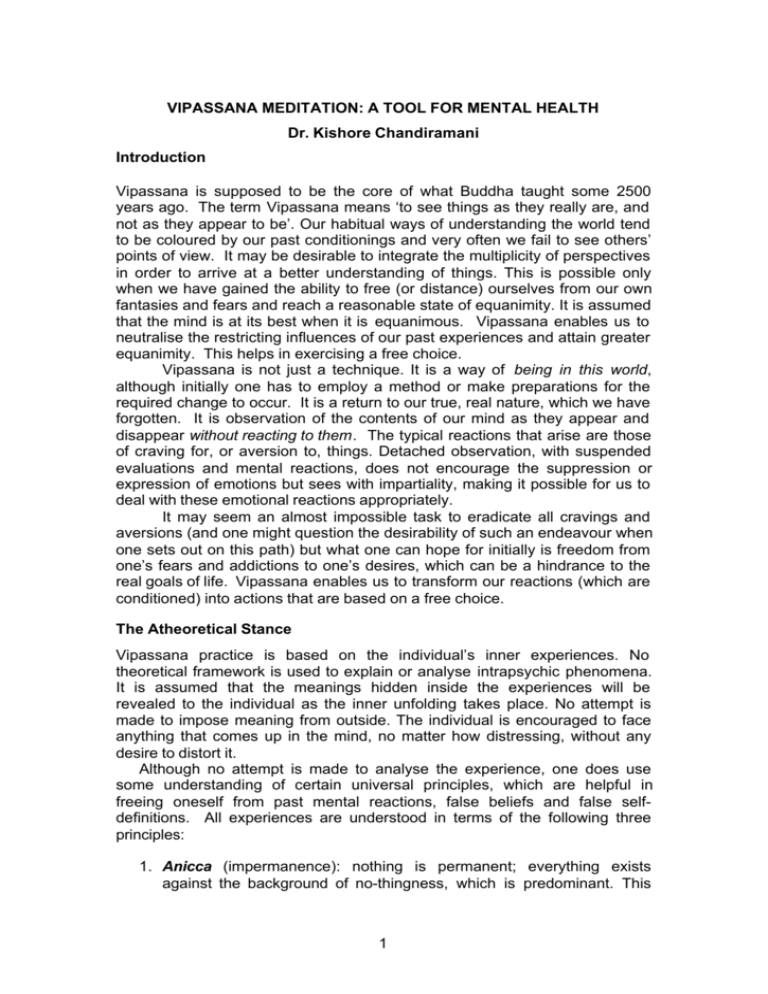
VIPASSANA MEDITATION: A TOOL FOR MENTAL HEALTH Dr. Kishore Chandiramani Introduction Vipassana is supposed to be the core of what Buddha taught some 2500 years ago. The term Vipassana means ‘to see things as they really are, and not as they appear to be’. Our habitual ways of understanding the world tend to be coloured by our past conditionings and very often we fail to see others’ points of view. It may be desirable to integrate the multiplicity of perspectives in order to arrive at a better understanding of things. This is possible only when we have gained the ability to free (or distance) ourselves from our own fantasies and fears and reach a reasonable state of equanimity. It is assumed that the mind is at its best when it is equanimous. Vipassana enables us to neutralise the restricting influences of our past experiences and attain greater equanimity. This helps in exercising a free choice. Vipassana is not just a technique. It is a way of being in this world, although initially one has to employ a method or make preparations for the required change to occur. It is a return to our true, real nature, which we have forgotten. It is observation of the contents of our mind as they appear and disappear without reacting to them. The typical reactions that arise are those of craving for, or aversion to, things. Detached observation, with suspended evaluations and mental reactions, does not encourage the suppression or expression of emotions but sees with impartiality, making it possible for us to deal with these emotional reactions appropriately. It may seem an almost impossible task to eradicate all cravings and aversions (and one might question the desirability of such an endeavour when one sets out on this path) but what one can hope for initially is freedom from one’s fears and addictions to one’s desires, which can be a hindrance to the real goals of life. Vipassana enables us to transform our reactions (which are conditioned) into actions that are based on a free choice. The Atheoretical Stance Vipassana practice is based on the individual’s inner experiences. No theoretical framework is used to explain or analyse intrapsychic phenomena. It is assumed that the meanings hidden inside the experiences will be revealed to the individual as the inner unfolding takes place. No attempt is made to impose meaning from outside. The individual is encouraged to face anything that comes up in the mind, no matter how distressing, without any desire to distort it. Although no attempt is made to analyse the experience, one does use some understanding of certain universal principles, which are helpful in freeing oneself from past mental reactions, false beliefs and false selfdefinitions. All experiences are understood in terms of the following three principles: 1. Anicca (impermanence): nothing is permanent; everything exists against the background of no-thingness, which is predominant. This 1 leads to a state of unsatisfactoriness, which is at the bottom of human life, and one begins to question the essence of things. 2. Anatta (egolessness or non-identification): not identifying oneself with what one encounters during introspection. It is not a denial or disowning parts of ourselves but recognition of false identifications and letting go of things that we are holding on to out of our own insecurities. 3. Dukkha (suffering): this is the corollary of impermanence. One can think of two different types of suffering, in-built and self-created. In-built suffering is not related to anything in particular. It is about eventual nothingness or uncertainty about things. In spite of our best efforts we remain subject to chance and battle with doubts about the fairness of human life. It is easier to avoid self-created suffering as it originates from our own mental reactions, self-definitions and the conclusions we draw about our experiences and the world in general. There is a link between the two types of sufferings. Our unwillingness to accept inbuilt suffering makes us react in certain ways leading to further suffering. Vipassana encourages us to confront the ultimate concerns pertaining to in-built suffering. The ‘acceptance of suffering’ in Buddhist psychology is generally misunderstood as a nihilistic approach. The acceptance should not be viewed as the end point. Rather, it is a means of achieving the goal of total eradication of suffering. Even in-built suffering dissolves with the dissolution of one’s ego. It becomes a non-issue as one transcends the human ways of looking at things. The Ten Day Course The practice of Vipassana is divided into three parts, sila, samadhi and panna, being respectively, morality, concentration and wisdom. Sila, or virtuous living, is the basis for samadhi (control of mind leading to onepointedness). In turn, it is only when samadhi is attained that one can develop panna. Therefore, sila and samadhi are the prerequisites for panna. By panna is meant the understanding of annica, annata and dukkha, through the practice of Vipassana. Students wishing to learn Vipassana undergo a minimum ten-day residential course, during which time they take the precepts not to kill, not to steal, not to commit sexual misconduct, not to speak lies and to refrain from intoxicants. For the entire ten days they do little other than sleep, eat, meditate and wash. For the first three days, concentration of the mind is developed by observing the inhalation and exhalation of the breath, and the consequent sensations that arise. From the fourth day, students learn to feel sensations inside the body in order to awaken the insights related to the mind and matter. Each day’s progress is explained during an hour’s discourse in the evening. The course closes on the last day with the practice of lovingkindness meditation, the sharing of the purity developed during the course with all beings 2 Embodiment Meditators in the tradition of Vipassana work at the body level. It is assumed that the mind exists in each and every living cell of our body and therefore to change the mind one has to work at one’s body level. The brain is considered an important organ regulating consciousness but there are many important functions of the mind that happen outside our heads, in a complex network of energy spread all over the body. Many complex tasks are precognitive and pre-linguistic and they tend to bypass our conscious awareness. They are mediated through internal body sensations and symbolic representations connecting our sensations with our thoughts. Sensations as the roots of experience We know that there are many experiences for which the corresponding thought forms do not exist, but it is inconceivable to think of an experience that does not involve inner body sensations. These sensations result from the contact of our five senses with the outside world, but they can also be triggered by the residual or resultant consciousness of past experiences, which remain dormant in the unconscious. Reflecting our consciousness on to thought alone will take us to a certain point, but reflecting it on to the sensation level will enable us to experience things in totality. Such inner sensations are not experienced in the normal waking state (although they may be elicited when listening to music, or in extreme conditions such as fever, illness or fatigue). But these sensations are available at all times, being linked with the functioning of our unconscious mind, in each and every cell of the body. It is we who ordinarily fail to perceive them. The practice of Vipassana enables one to experience these sensations, laid down as representations of our past actions or conditionings. Each action, whether by word or thought or deed, leaves behind an active force called sankhara (also known as kamma), which accumulates to the credit or debit ‘account’ of the individual, depending upon the nature of the deed. The understanding of the three characteristics of impermanence, suffering and non-identification enables us to rid ourselves of the sankhara, which has accumulated in this account. A comparison with scientific models Psychoanalysis. Vipassana shares the psychic deterministic view and acknowledges the existence of unconscious. Like psychoanalysis, Vipassana leads to an uncovering of the unconscious mind. Past experiences are relived. Whilst reliving, the meditator is able to achieve a different understanding, through the realisation of the three characteristics of impermanence, nonidentification and suffering. While it is held that the cause and effect rule operates in the mind, a part of the mind remains free from this conditioning and thus can create new causes and neutralise the effects of previous causes. The client-centred approach. Vipassana is humanistic in nature, being a non-judgemental approach that leads to inner unfolding, and it assumes that the basic nature of human beings is good. The important difference is that whereas the client-centred approach focuses on emotions through verbal 3 means, Vipassana is concerned with the totality of our experiences and consciousness and the work is done more effectively in silence. Behavioural approaches. The model of biofeedback can be used to explain the change process. Staying with the distress without reacting completes a feedback loop which leads to the dissolution of distress and enables in-built healing mechanisms to function. Conclusion Vipassana is not a simple undertaking. It is a deep journey into the mind that can be at times distressing, but the gains are proportionate to the effort, time and dedication given. Change does not come by accident or miracles. Vipassana works on the basis of the scientific principle of cause and effect. One has to work hard at one’s past conditioning to experience the higher and subtler forms of realities hidden inside the deeper reaches of the mind. On this path one learns after a while that the peace which comes from within is much more enjoyable than the transient excitements and happiness which can be obtained from without. Further information on Vipassana is available on the following websites: www.dhamma.org and www.vri.dhamma.org © Kishore Chandiramani 2001 4
